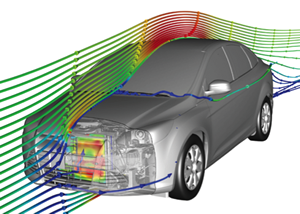Ford Asks ORNL to Take a Look Under the Hood
In the past, valuing one feature in a car about all others has come with an understood set of trade-offs: if you wanted an SUV, you knew you wouldn’t be getting fuel efficiency; If you wanted an alternative energy vehicle, you accept that it won’t have as much to offer in the way of power. That’s not to say that car buyers wouldn’t value the vehicle that touted the lowest trade-off, but it did give automakers some leeway in terms of design.But not anymore.
 Since the Obama Administration mandated that new cars average 35.5 miles per gallon (mpg) by 2016 and 54.5 mpg by 2025, car design has entered an age that requires more ingenuity than ever before. Still, as a beacon of American ingenuity, Ford is tackling the problem head-on.
Since the Obama Administration mandated that new cars average 35.5 miles per gallon (mpg) by 2016 and 54.5 mpg by 2025, car design has entered an age that requires more ingenuity than ever before. Still, as a beacon of American ingenuity, Ford is tackling the problem head-on.
“The continuous improvement in fuel economy of our vehicles is one of the key goals of the Ford product development team,” said Burkhard Hupertz, the thermal and aerosystems computer-aided engineering (CAE) supervisor at Ford of Europe. “Delivering a more energy-efficient vehicle while maintaining design leadership and high-package efficiency, and fulfilling future safety standards, is a very complex task requiring a new engineering approach.”
With everything from bodywork to weight contribute to fuel economy, a vehicle’s engine bay remains a key piece to the puzzle that Ford is trying to solve. Although the air that comes in through the front intake is essential to cooling the engine, it also adds a significant amount of drag that only adds to the vehicle’s workload.
To tackle the problem of drag due to engine bay airflow while still managing to cool the engine, Ford turned to Oak Ridge National Laboratory (ORNL) to tap the resources of its Jaguar supercomputer.
Ever since the first Model T rolled off Ford’s assembly line, automotive manufacturing has been based first and foremost on physical testing. While we no longer design our cars based on the ease of manufacturing, as was the case for the boxy “Tin Lizzie,” high-performance computing-enabled engineering that enabled the creation of more aerodynamic vehicles has only been around since the mid-1980s. Back then, Ford was using a Cray X-MP to create its first computational fluid dynamics (CFD) code, Underhood 3D.
But even though simulations such as these have not yet fully replaced physical testing, times are undoubtedly changing.
“CAE with high-performance computing is unquestionably an integral part of today’s design process in all development phases,” said Hupertz.
To successfully simulate the fluid dynamics of airflow through an engine bay, ORNL’s Jaguar must first have a detailed model of every compartment and component that constitutes the bay, as each additional item complicates the equation and could skew the simulation’s findings.
Most important to the cooling airflow are the size and placement of the front opening, the position of heat exchangers, features that affect flow such as active grill shutters and speed flaps.
“Any change in the size and position of just one component can have a significant impact on the computational model as a whole, Hupertz said. “Making one more efficient could result in the loss of cooling or increased drag for another.”
But geometric features aren’t the only variables in play that the Jaguar must contend with. For starters, fan power could profoundly affect cooling, and there are a number of environmental conditions that should be dealt with, from external temperature to engine speed, terrain or even whether the vehicle is towing an additional load such as a trailer or caravan.
Testing of this detail—examining the complete underhood design along with a variety of operational conditions simultaneously—requires thousands of simulations and thus represents a challenge that far exceeds anything Ford has attempted in the past.
When the team was awarded time on the Jaguar through ORNL’s HPC Industrial Partnerships Program, the supercomputer was the Department of Energy’s most powerful HPC systems and a key player in the global HPC community.
After tweaking the Underhood 3D code for the system, Ford used roughly 1 million processor hours to test 11 parameters over four operating conditions, which totaled 1,600 simulations. And perhaps even more impressively, the team completed the simulations quickly enough to meet the deadline of their vehicle development project.
Since then, Jaguar has been upgraded to Titan, which holds the title as the country’s most powerful super.
As for Ford, the Jaguar simulations helped to develop a new vehicle platform and refine their R&D to cut the number of physical prototypes and tests that will be required to optimize their new vehicles.
“In particular,” said Hupertz, “we should be able to significantly reduce the unexpected and unplanned retesting, which are the most expensive.”
Not only that, but the time spent with Jaguar helped Ford management to experience the benefits that the company would see after upgrading its own HPC resources.
“Access to Jaguar provided Ford the ability to evaluate the impact of using a large-scale system in these important engine bay package optimization studies,” said senior HPC technical specialist and lead investigator Alex Akkerman. “The results provided important return-on-investment justification for a significant upgrade to Ford’s in-house computing resources for similar and other automotive CAE projects.”










